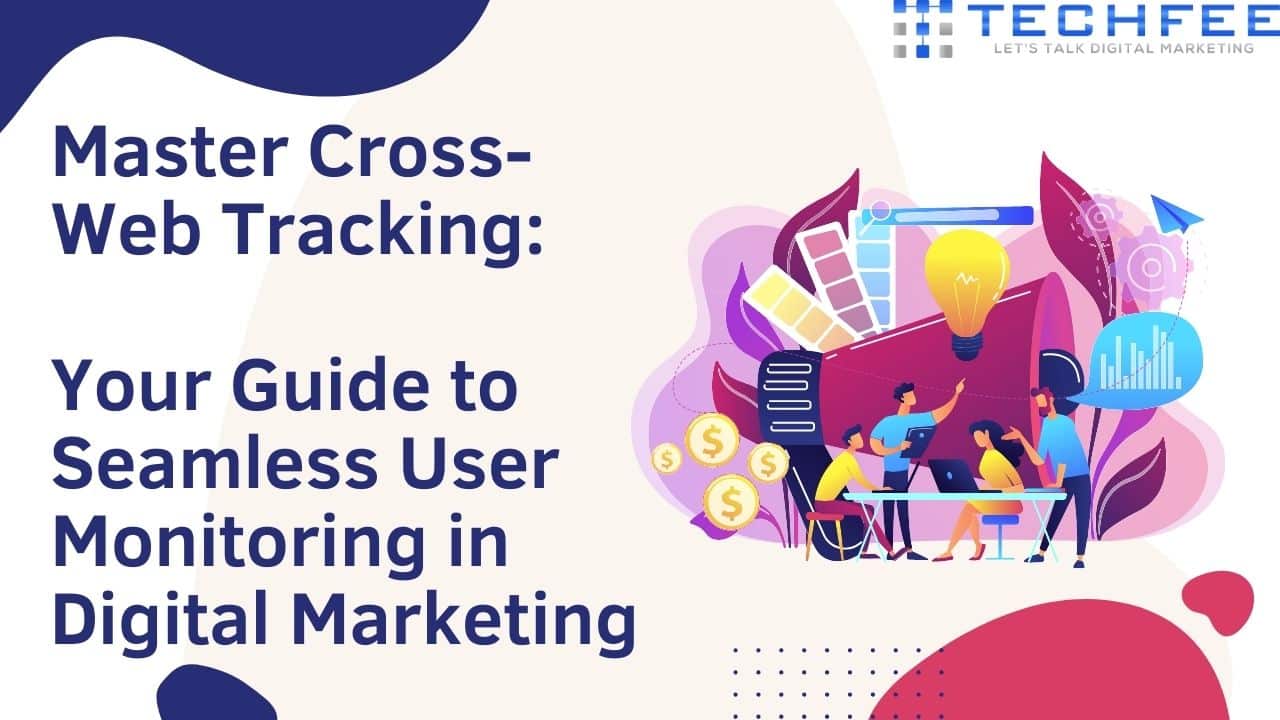If you want to understand deeply what is the digital marketing strategy that tracks users across the web, then you are at the right page and going to be part of this crucial discussion here.
As we all know, digital marketing is like a magic wand for businesses in today’s online world. It’s all about using the internet to tell people about your products or services.
Just think about all the times you’ve seen ads on Facebook, Google, or Instagram – that’s the actual digital marketing in action! But here’s the thing: you need a solid plan to make it work.
It’s not enough to just be online; you have to know how to stand out and grab people’s attention. That’s where a good digital marketing strategy comes in.
In this article, we’ll dive into what makes a digital marketing strategy tick and why it’s crucial for businesses today. Plus, we’ll share some insider tips to help you ace your digital marketing game.
So, without any further delay, let’s get started!
What Does Digital Marketing Strategies Stand for?
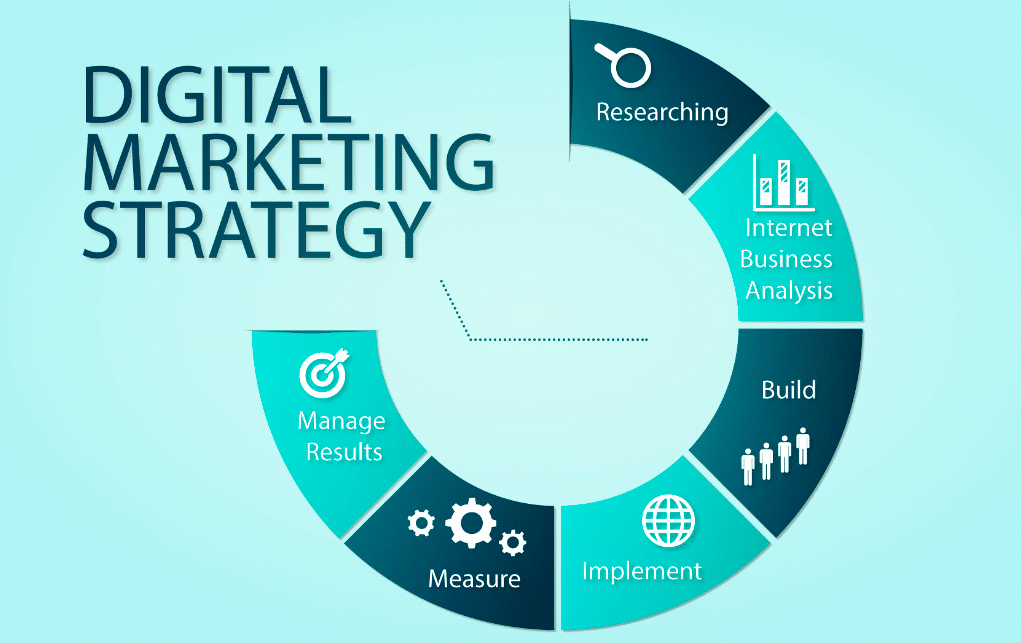
Digital marketing strategies are like guides for businesses in the online world. Their plans show how a company will use the internet to reach people interested in their offer.
These strategies involve lots of different things, like making exciting posts on social media, showing up on Google searches, sending emails, and more.
The main goal is to get attention, bring visitors to the website, get them interested, and make some sales.
Whether posting on Facebook, showing up first on Google, or sending out emails, digital marketing strategies help businesses succeed online.
Types of Digital Marketing Strategies
Search engine optimization (SEO)
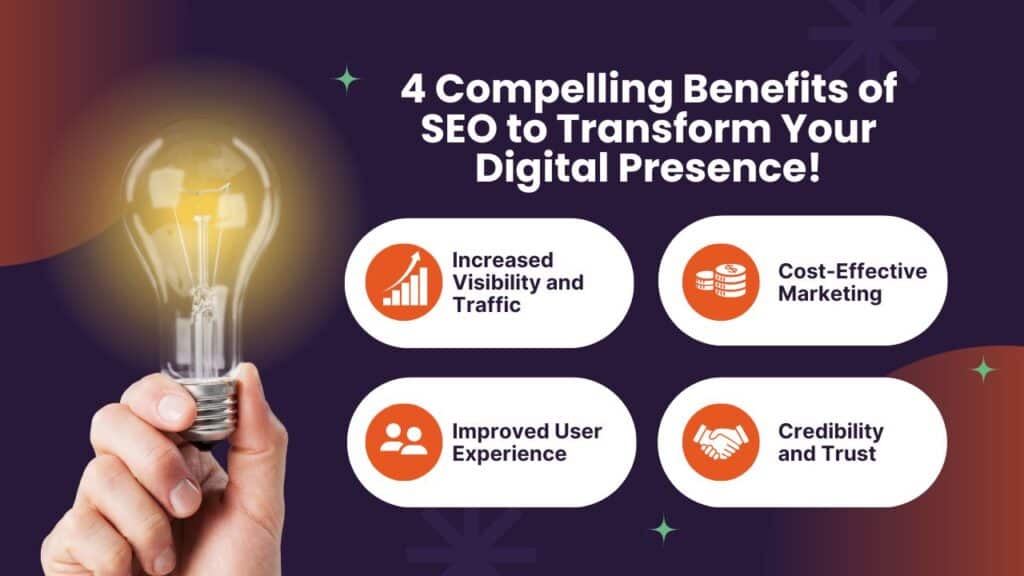
Improving your website’s visibility through SEO involves tweaking its content to rank better for relevant keywords in your industry. The more keywords your site ranks for and the higher it appears in search results, the more exposure and recognition your business can gain.
SEO is all about attracting the right kind of traffic to your website – people who are actively looking for the products or services you offer.
By optimizing your online presence for search engines, you can effectively capture the attention of potential customers at different stages of their buying journey.
Why is it so crucial? Well, in the world of digital marketing, it’s a must-have. It allows you to connect with potential customers at every stage of their buying process because almost everyone starts their search for a new product or service on a search engine.
Consider this: more than half of consumers now prefer shopping online. And to do that, they turn to search engines like Google to find what they need.
By incorporating SEO into your online marketing strategy, you can tap into this search traffic and turn it into valuable sales opportunities.
Read this Related Article: Top 15 On-Page Seo Techniques 2024: The Complete Guide
Pay-per-click (PPC) advertising
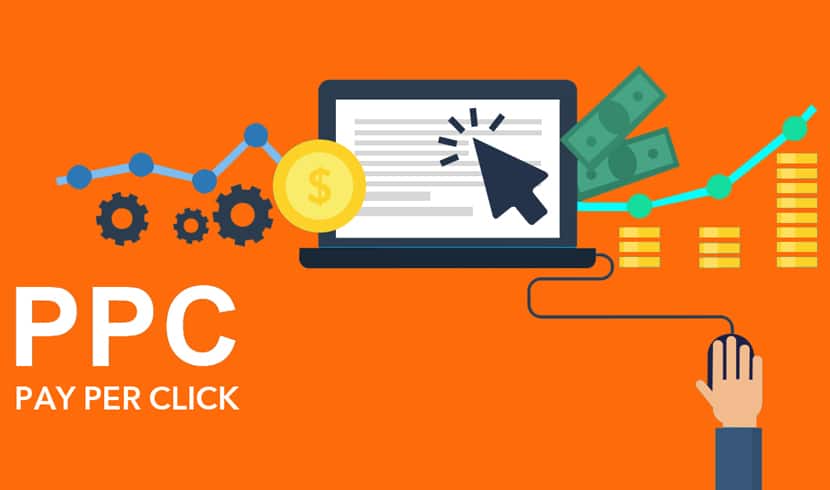
PPC, which stands for Pay-Per-Click, is advertising where you bid on keywords relevant to your business. When users search for those keywords, your ads can appear at the top of the search results. You only pay when someone clicks on your ad, not just for the space it occupies.
The beauty of PPC lies in its ability to target users actively looking to make a purchase or take action. By directing them to a specific landing page with a compelling call-to-action, PPC helps turn clicks into conversions.
So why choose PPC? It’s known for being a cost-effective advertising method, especially for businesses looking to make a quick impact in the digital realm.
When your organic search ranking may not be where you want it to be, PPC can swiftly propel your website to the forefront of search engine results.
Read this Related Article: 10 Effective Paid Marketing Strategies To Skyrocket Your Business In 2024
Content marketing

With content marketing, your company focuses on engaging and connecting with customers by providing valuable information. This can include various forms of content like videos, blogs, infographics, and more, all aimed at addressing their needs and interests.
Imagine you own a business selling gym equipment. You could create articles discussing what beginners need for their initial fitness journey, how to properly use equipment and recommendations for tricks and techniques that enhance fitness performance.
The main goal of content marketing in digital marketing is to offer valuable insights to your target audience, driving website traffic and encouraging conversions.
Content marketing also involves optimizing your content for search engines to improve your visibility online.
So, why choose content marketing? Unlike paid advertising, it allows you to engage with customers at every stage of the buying process.
Plus, you earn traffic through the quality of your content rather than paying for it directly.
Read this Related Article: How To Create Interactive Content: 10 Techniques That Drive Shares And Engagement
Email marketing
Email marketing is a critical strategy in digital marketing, encompassing the art of nurturing leads, fostering brand loyalty, and showcasing products or services directly to your audience through email.
This approach revolves around the dual objectives of retaining existing customers and attracting new ones, making it a powerful tool for bolstering brand recognition, maintaining a solid company presence, and encouraging repeat purchases.
The crux lies in cultivating brand awareness, ensuring that even if users don’t need your offerings, they’ll have your brand in mind when the time for a purchase arises. This recognition significantly increases the likelihood of them choosing your company over competitors.
At its essence, email marketing aims to stay at the forefront of potential customers’ minds while simultaneously providing existing clients with valuable resources, such as industry insights and personalized content like exclusive discounts or product offers, to foster ongoing engagement.
So, why opt for email marketing? Its advantages are numerous and varied. Unsurprisingly, many businesses, spanning diverse industries from manufacturing to retail to technology, rely on email marketing as a core component of their marketing strategies.
One of its most compelling advantages is its remarkable return on investment (ROI), which averages $35 for every $1 spent. This impressive ROI underscores the profitability and effectiveness of email marketing, solidifying its status as an indispensable tool in modern marketing endeavors.
Read this Related Article: 27 Effective Email Marketing Strategies: The Ultimate Guide For Boosting Your Sales
Social media marketing

Social media marketing revolves around boosting brand recognition and driving conversions.
A well-crafted social media marketing campaign can utilize various platforms like Facebook, Instagram, Pinterest, and LinkedIn. Besides crafting engaging organic content, businesses can leverage paid social media advertisements.
But why should one consider social media? Surprisingly, less than 30 percent of companies currently incorporate social media into their marketing strategies, leaving a considerable opportunity untapped.
Moreover, with nearly 3.5 billion active social media users worldwide, it’s a prime avenue for connecting with your target audience.
Read this Related Article: 17 Social Media Marketing Strategies That Will Take Your Business To The Top
Voice search optimization
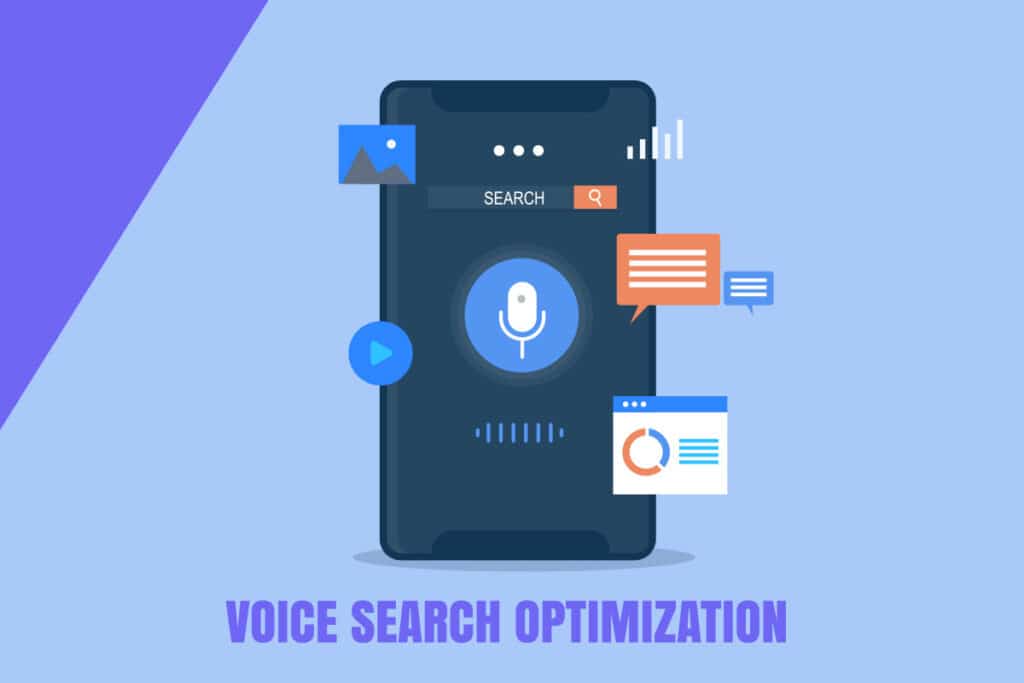
By incorporating voice search optimization, your company can refine existing and new website content to cater to the needs of users who rely on voice-based searches. The main aim is to secure a prominent position for your website, such as the featured snippet or position zero, on Google’s search results page.
But why is this so crucial? Well, think about the various voice-activated assistants like Siri or Amazon Echo. They heavily depend on the featured snippet to answer users’ voice queries quickly.
For instance, if someone asks, “How do I get rid of that funky smell in my dishwasher?” Amazon Echo or Siri would promptly offer information from the featured snippet.
Given the differences between how people search using voice and text, optimizing for voice searches becomes incredibly important. This is especially true for local businesses, as many users use their mobile devices and voice search to find nearby eateries, salons, or hardware stores.
So, why should your company invest in voice search optimization?
With the rising popularity of smartphones and voice-enabled devices, voice search has become a preferred method for many.
It’s not just a trend; it’s a significant avenue for digital marketing that businesses must pay attention to.
Read this Related Article: Unlock The Power Of Voice Search: Top Strategies On How To Optimize Content For Voice Search
Video Marketing

Utilizing video marketing presents a dynamic opportunity for your company to extend its reach, drive revenue growth, and expand its operational horizons. Like in content marketing, your business needs to prioritize creating engaging video content that resonates with your target audience.
There are various types of marketing videos you can explore:
- How-to or instructional videos
- Exciting announcement videos
- Behind-the-scenes glimpses
- Captivating event coverage
- And more!
Regardless of the specific type, the overarching objective remains consistent: to enhance brand awareness among your desired audience.
Similar to the ripple effect seen in social media, email, and content marketing efforts, this heightened brand visibility lays the groundwork for meaningful conversions in the future.
Why embrace video marketing? Because it consistently proves its ability to drive conversion rates higher, video marketing is swiftly becoming a cornerstone strategy in the online marketing realm.
Furthermore, it seamlessly integrates with email marketing and content marketing strategies, enhancing their effectiveness by including engaging video content.
Read this Related Article: 16 Video Marketing Strategies To Make Your Content Go Viral In 2024
Essential Tools to Execute a Digital Marketing Strategy
These tools are the backbone of boosting your brand’s visibility and connecting with your audience meaningfully. Let’s take a closer look at some of these indispensable digital marketing essentials:
Your Website: Think of it as your online headquarters. It’s crucial to keep it optimized so that people can easily find you and have a great experience once they’re there.
Feedback Channels: Building trust and gathering insights from customer feedback are overlooked but fundamental aspects of any successful marketing strategy.
Social Media Engagement: Platforms like Facebook, Twitter, and Instagram offer potent ways to connect with your audience and build communities around your brand.
Directory Listings: Make sure your business is listed in various directories to expand your reach. Visuals and keywords play a significant role in optimizing these listings.
Content Strategy: Creating valuable and original content is vital. Look at successful examples like Parabol to see how it’s done right.
Personalized Emails: Building relationships through targeted email campaigns can increase conversion rates.
SEO Know-How: Understanding the ins and outs of search engine optimization is crucial for getting more organic traffic to your website.
Digital Advertising: With the right content and targeting, digital ads can drive significant traffic, leads, and conversions.
AI Integration: Embracing artificial intelligence can streamline tasks like content creation and data analysis, making your marketing efforts more efficient and effective.
How to Build a Digital Marketing Strategy
Build buyer personas
Buyer personas will most likely be interested in and purchase your products or services.
Essentially, they act as imaginary profiles embodying your ideal audience, enabling you to refine your marketing efforts for better sales and revenue outcomes.
Developing a buyer persona involves a deep dive into your target customer base’s interests, needs, and demographics.
For instance, if you notice a significant portion of your buyers are women aged between 40 and 60 residing in Texas.
Using this understanding, you can create a persona like Mike—a 55-year-old man from Downstreet with a genuine interest in your offerings. While Mike isn’t a real person, he mirrors the characteristics of your desired audience.
Once you’ve crafted this buyer persona, you can tailor your marketing messages to resonate with his interests, driving him to purchase.
By customizing your marketing strategies to appeal to this persona, you effectively connect with the audience you’re striving to attract.
Table of Contents
ToggleSet goals and objectives
The essence of crafting a digital marketing strategy lies in accomplishing your desired outcomes. Establishing clear goals and objectives that resonate with your plan right from the start is crucial.
Utilize specific, measurable, achievable, realistic, and timely (S.M.A.R.T.) goals to steer your strategy. Take into account both short- and long-term growth aspirations for your organization.
For instance, you could aim to generate $500,000 in revenue within the current fiscal year. To achieve this, you might focus on enhancing website traffic, increasing product sales, and other pertinent initiatives.
Audit your existing digital channels
Before diving into any new Internet marketing approaches, it’s wise to take a step back and thoroughly assess your digital landscape. This involves examining all aspects of your online presence, including your website, social media presence, content, and email campaigns.
By conducting this evaluation, you gain valuable insights into what’s working well and where there’s room for improvement. This information guides your decision-making process as you refine your overall marketing strategy.
For example, you might discover that most of your website traffic originates from organic search results on Google. Armed with this knowledge, you can prioritize investing more resources into optimizing your site for search engines to capitalize on this traffic source further.
Establish a marketing budget
Ensuring your marketing plan keeps your finances strong and fits well with your company’s overall financial aspirations is vital.
Set up a practical budget for your strategy to clearly understand how much you can dedicate to different campaigns.
Consider creating several budgets for your plan. For instance, you could establish one budget for advertising and another for SEO, allowing for better control and allocation of resources.
Decide which digital marketing strategies you want to invest in
Once you’ve set your budget, it’s time to weigh the options for online marketing strategies worth investing in. While spreading your funds across various tactics is tempting, your budget might limit your choices. In such cases, it’s essential to prioritize strategies that promise the best returns.
Ensure the strategies you opt for align with your broader business goals. Consider where your target audience spends most of their time online. Are they active on specific social media platforms, or do they mainly find you through Google searches?
Focus on techniques that bring genuine value to your business and industry rather than unthinkingly following the latest trends. It’s essential to make well-informed decisions to propel your business towards achieving its objectives.
Plan out your strategies
Set your marketing strategy on the path to success by dedicating time to thoughtful planning. If you’re venturing into paid advertising, assessing your budget allocation carefully is crucial.
Similarly, when it comes to content creation, crafting a detailed content calendar is essential.
Furthermore, it’s essential to designate roles and responsibilities within your team for different marketing initiatives. The composition of your team will determine who takes on what tasks.
In cases where your marketing team is small or nonexistent, partnering with a professional marketing agency could be a viable solution to ensure the effective execution of your strategies.
Monitor and report
Once you’ve launched your campaigns, the real work begins. It’s not about reaching the finish line but starting a constant monitoring and evaluation journey. Your task is to closely monitor the performance of your strategies by tracking important metrics.
Understanding the success of your online strategies is critical to improving them and getting a better return on your investment. For example, your social media ads generate more results than your PPC ads.
Armed with this knowledge, you can adjust your investment accordingly. You may allocate more resources to social media advertising while reducing spending on PPC campaigns.
This way, you can drive even more sales and revenue, ensuring your budget is well-spent on effective strategies. Alternatively, you can tweak and optimize your PPC campaigns for better performance.
Utilize tools like Google Analytics, Google Search Console, and Google Ads to stay informed about the performance of your strategies and their impact on your ROI.
Understanding User Tracking

Understanding user tracking is essential for grasping the inner workings of digital marketing strategies that trace users across the web.
User tracking systematically monitors individuals’ online behaviors, including browsing activities, content interactions, and engagement with advertisements.
The evolution of user tracking technologies has been significant, from essential cookies to sophisticated methods such as pixel tracking, fingerprinting, and cross-device tracking.
These advancements have empowered marketers to craft more targeted and personalized campaigns.
However, this progress brings about legal and ethical considerations.
Privacy regulations like GDPR and CCPA have been established to safeguard users’ rights and regulate the collection and utilization of their data.
Striking a balance between the benefits of user tracking and respecting privacy and ethical standards is paramount for marketers navigating the digital landscape.
Which Digital Marketing Strategies Are Most Effective?
In this strategy for digital marketing, it’s critical to monitor and keep tabs on user actions and behavior across various devices.
Consequently, the principal tracking methods employed encompass device fingerprinting, cookies, login credentials, IP address tracking, and other relevant techniques.
A. Cookies and Tracking Pixels
Cookies are small files stored on a device, retaining a record of activities performed on a website.
B. IP Address Tracking
IP address tracking is a crucial aspect of digital marketing strategy, allowing marketers to monitor user activity across the web. Capturing unique IP addresses associated with devices enables personalized marketing efforts and targeted advertising.
This data also helps measure campaign effectiveness and optimize marketing strategies for better engagement and conversions. IP address tracking empowers businesses to enhance their online presence and drive successful marketing outcomes.
C. Device Fingerprinting
The practice of gathering data and details regarding a user’s device is known as device fingerprinting. This data typically includes the operating system, installed applications, and screen dimensions.
D. Login Credentials
Observing user behavior through login credentials is an effective method of tracking. When users log in or out, multiple activities co-occur. The data saved during these events is leveraged to generate comprehensive user interest and behavior reports. These reports are instrumental in informing decisions for digital marketing campaigns, taking into account user preferences.
Challenges and Solutions in User Tracking
One significant hurdle arises from the widespread adoption of ad-blocking tools and privacy safeguards, which obstruct the collection of vital user data necessary for targeted advertising and personalized marketing campaigns.
To navigate this obstacle, marketers must adapt their strategies by incorporating contextual targeting and fostering genuine user engagement to connect with audiences organically.
Additionally, the ever-growing trend of users switching between multiple devices poses a challenge to maintaining a cohesive understanding of their online behavior.
Marketers can piece together fragmented user journeys across various devices by implementing robust identity resolution systems and leveraging advanced data analytics.
Moreover, accurately attributing conversions and assigning credit to different touchpoints along the customer journey remains a complex puzzle.
To address this, marketers can explore multi-touch attribution models and utilize machine learning algorithms to discern the true impact of each marketing channel.
By proactively addressing these challenges with innovative approaches, marketers can forge deeper connections with users while effectively navigating the intricacies of user tracking in the digital landscape.
Maximizing User Tracking for Effective Marketing
Maximizing user tracking for effective marketing requires a comprehensive strategy that focuses on enhancing user engagement and boosting conversion rates:
Personalized and customized marketing efforts are vital to connecting with individual preferences and behaviors. By leveraging insights gained from user tracking, marketers can craft tailored campaigns that resonate with specific audience segments, fostering deeper connections and loyalty.
Retargeting strategies play a crucial role in re-engaging users who have previously interacted with a brand but have yet to take the desired action, such as purchasing. Through strategically placing personalized ads across digital channels, marketers can reinforce brand messaging and nudge users toward conversion.
A/B testing and optimization allow marketers to refine their strategies by experimenting with different approaches and analyzing user response data.
By continually testing and tweaking campaigns based on insights gleaned from user tracking, marketers can uncover the most effective tactics for driving engagement and achieving marketing goals.
Measuring Success and Key Performance Indicators (KPIs)
Assessing the effectiveness of a digital marketing strategy that monitors users across the web involves keen attention to various key performance indicators (KPIs):
Understanding user engagement is crucial. Metrics like click-through rates, time spent on site, bounce rates, and social media interactions offer valuable insights into how well the campaign connects with the intended audience.
Conversion rate optimization is vital. This aspect transforms user engagement into measurable actions like registrations, purchases, or downloads. Analyzing conversion rates throughout the customer journey helps marketers pinpoint areas for enhancement and fine-tune their approaches accordingly.
Evaluating return on investment (ROI) is essential.
ROI provides a comprehensive view of the campaign’s success by comparing financial gains with the resources invested. It factors in monetary returns and acquisition costs, offering insights into the campaign’s profitability and effectiveness.
How Will This Digital Marketing Strategy That Tracks Users Across The Web Benefit Your Business?
Enhancement of User Experience: A business marketer possesses the capacity to enhance user engagement and improve user experience. Furthermore, the dissemination of pertinent content through digital media channels online could lead to an increase in conversion rates.
Enhanced Visibility: A well-executed digital marketing strategy can assist a business marketer for improving the visibility of users.
Data-Driven Decision-Making for Digital Marketing Strategies: Observing user behavior empowers marketers to base decisions on data. Moreover, it aids in crafting and enhancing effective digital marketing strategies.
Increased ROI: Crafting marketing campaigns tailored to a particular target audience has the potential to boost conversion rates. This, in turn, leads to a noticeable enhancement in return on investment (ROI).
Future Trends in User Tracking and Digital Marketing
Leveraging AI-powered algorithms, marketers are poised to delve into extensive data analysis, allowing for precise consumer preferences and action predictions.
However, navigating privacy regulations and compliance measures will be paramount amidst this technological evolution. With continuously evolving laws such as GDPR and CCPA, marketers must prioritize user consent and data protection in their tracking strategies.
Additionally, there’s a growing need for enhanced cross-channel integration, enabling seamless tracking of users across multiple platforms and devices.
This integrated approach offers marketers a holistic view of consumer journeys, facilitating targeted and personalized marketing initiatives across the digital spectrum.
Conclusion
In wrapping up, it’s clear that keeping tabs on users in digital marketing is super important for businesses.
When you track users online, you get to know them better and understand what they like and how they interact. This helps you shape your marketing in a way that really speaks to them.
Remember, it’s not just about having fancy tools but a solid plan that includes different ways to reach people.
You can make smarter decisions and build stronger customer relationships by paying attention to what works and what doesn’t.
So, as we look ahead, staying up-to-date with new trends in user tracking and digital marketing will be vital to staying ahead of the game and ensuring your business stays successful in the long run.
Hopefully, I have fulfilled your search intent in this article. If you have found this article informative and helpful, please share it with others and comment below with your valuable feedback.
Also, please stay connected with us by subscribing to our email newsletter to get these informative articles directly in your inbox.
Frequently Asked Questions
What is digital marketing?
Digital marketing uses digital channels, such as websites, social media, email, search engines, and mobile apps, to promote products or services, reach target audiences, and generate leads or sales.
What are the 5 main strategies of digital marketing?
The five main strategies of digital marketing are:
- Search Engine Optimization (SEO)
- Content Marketing
- Social Media Marketing
- Email Marketing
- Pay-Per-Click (PPC) Advertising
What is a digital marketing campaign?
A digital marketing campaign is a coordinated series of online marketing efforts to achieve specific business goals, such as increasing brand awareness, driving website traffic, generating leads, or boosting sales. It typically involves strategically using various digital channels, such as social media, email, search engines, and content platforms, to deliver targeted messages to the intended audience.
Is user tracking ethical?
The ethics of user tracking depend on various factors, including transparency, consent, and the intended use of the data. In some contexts, user tracking can enhance user experience and provide valuable insights for businesses. Still, it must be conducted responsibly, with clear communication about data collection practices and respect for user privacy rights. Unethical user tracking practices, such as invasive data collection without consent or misuse of personal information, are unacceptable.
How can businesses ensure data privacy while tracking users?
Businesses can ensure data privacy while tracking users by implementing the following measures:
- Obtain explicit consent: Communicate the purpose of data collection to users and obtain their consent before tracking their activities.
- Anonymize data: Remove personally identifiable information from collected data to minimize the risk of individual identification.
- Implement robust security measures: Use encryption, firewalls, and other security measures to protect user data from unauthorized access or breaches.
- Provide transparency: Be transparent about the types of data being collected, how it will be used, and with whom it may be shared.
- Offer opt-out options: Users can opt out of tracking if they prefer not to have their activities monitored.
- Regularly review and update privacy policies: Keep privacy policies up to date and ensure compliance with relevant regulations to maintain user trust.
What are the common challenges faced in implementing user tracking strategies?
Common challenges faced in implementing user tracking strategies include:
- Privacy concerns: Users may be wary of their data being tracked and resist or opt out of tracking, impacting the strategy's effectiveness.
- Technical limitations: Tracking technologies may face technical issues such as compatibility issues across devices and platforms or inaccuracies in data collection.
- Compliance with regulations: Businesses must navigate complex privacy regulations such as GDPR or CCPA, ensuring their tracking practices are compliant.
- Data security risks: Collecting and storing user data poses security risks, such as data breaches or unauthorized access, which can damage trust and reputation.
- Balancing personalization and privacy: There is a fine line between personalizing user experiences based on tracked data and respecting user privacy preferences, requiring careful consideration and implementation.
How can small businesses benefit from user tracking?
Small businesses can benefit from user tracking by gaining valuable insights into customer behavior, preferences, and trends. This information allows them to:
- Improve targeting: Understand their audience better and tailor marketing efforts to reach potential customers more effectively.
- Enhance user experience: Analyze user interactions with their website or app to identify areas for improvement and optimize the overall user experience.
- Increase conversion rates: Use data-driven insights to refine sales strategies and conversion funnels, ultimately boosting sales and revenue.
- Measure marketing effectiveness: Track the performance of marketing campaigns in real time and make data-driven decisions to optimize marketing spend and ROI.
- Foster customer loyalty: Personalize communication and offerings based on user preferences, increasing customer satisfaction and retention.
What are the best practices for maximizing the effectiveness of user tracking in digital marketing?
The best practices for maximizing the effectiveness of user tracking in digital marketing include:
- Obtain explicit consent: Ensure users know and consent to being tracked, respecting their privacy preferences.
- Focus on relevant data: Collect and analyze data that aligns with your marketing objectives and provides actionable insights.
- Implement robust security measures: Protect user data with encryption, secure storage, and regular security audits to prevent breaches.
- Provide transparency: Communicate your data collection practices and how user data will be used, building trust with your audience.
- Respect user preferences: Offer options for users to control or opt out of tracking, respecting their right to privacy.
- Regularly review and refine tracking strategies: Monitor and adjust tracking methods to ensure relevance and effectiveness over time.
